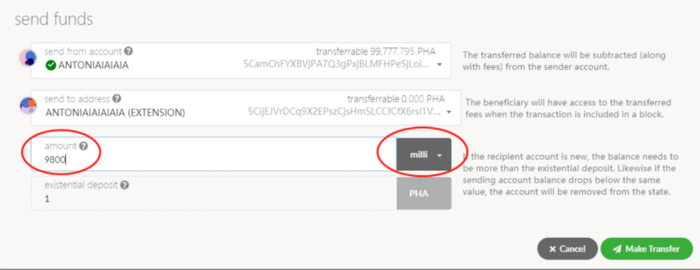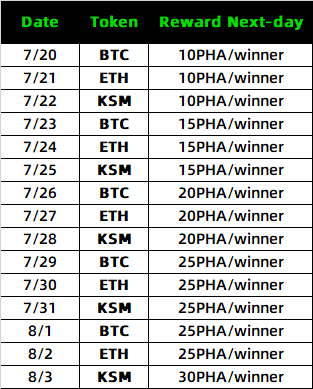



2. Join https://t.me/phalanetwork for known community better, join https://t.me/phalafaucet and input /drip [your testnet address] to get PHA testnet tokens.
Phala team prepared over 100,000 PHA for testnet Rorschach. The incentive program will be officially launched on UTC 10 am, July 20, 2020.

1. The Awakening of Nodes
WHEN: July 20 — Aug 20
In this quest, you will gain different points for completing different achievements. The more points you have, the more PHA rewards you will proportionally share at the end of this event.

Once your node is set up, your points will automatically be computed and displayed on “Awakening Points Dashboard”.
Here is a table indicating the estimated PHA reward for 240 nodes achieving different user cases.

2. Test and Claim
WHEN: July 20 — Until next upgrade
Follow the Guide, test the following functions, and 10 PHA will be dropped to your ETH address.
(The Guide link will be updated later before the official launch day)
1. On-chain identity identification
2. Private asset converting
3. Stake and nominate
4. Submit a proposal and vote for a proposal
5. Apply council and vote for a candidate
3. Secret Price Guessing Game
WHEN: July 20 — Aug 3
Follow the Guide and use Phala private transfer function to guess the price of BTC/ETH/KSM.
(The Guide link will be updated later before the official launch day)

- Time to predict: UTC 10:00–10:30 am each day
- Meaning of transferred mllli: the price of BTC/ETH/KSM after 24 hours.
The ones whose predictions are most close to the real-time price next day will be the winners of the day and win PHA rewards.

4. Master of Guide Writing
WHEN: July 20 — Aug 3
Publish guides or instructional videos online, and PHA reward will be dropped to your address.


Note that your guides should be original by yourself. Plagiarization will derive your rewards from all quests.
5. Artist of Text Art
WHEN: July 20 — Aug 3
Design or create Phala Testnet Rorschach Text Art with online tools. Publish them on Phala forum and your social media, 3 winners will each receive 100 PHA for their talent or popularity.

The transactions weights in Phala Network were benchmarked on standard hardware. It is recommended that Gatekeepers run at least the standard hardware in order to ensure they are able to process all blocks in time. The following are not minimum requirements but if you decide to run with less than this beware that you might have performance issue.
Standard Hardware
For the full details of the standard hardware please see here.
- CPU - 2 cores, with Intel SGX capability.
- Storage - A NVMe solid state drive. Should be reasonably sized to deal with blockchain growth. Starting around 80GB - 160GB will be okay for the first six months of Phala Network, but will need to be re-evaluated every six months.
- Memory - 2GB - 8GB. 2GB is really the minimum memory you should operate your Gatekeeper with, anything less than this make build times too inconvenient. For better performance you can bump it up to 4GB or 8GB, but anything more than that is probably over-kill. In order to compile the binary yourself you will likely need ~8GB.
Install Intel SGX driver & platform software
You can find the latest Linux SGX driver from the official download page. Make sure to install:
- SGX Linux DCAP Driver (Under /opt)
- SGX Linux SDK
- SGX Platform Swoftware



















